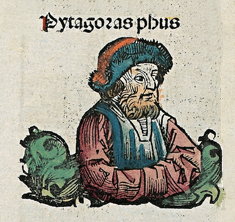Pythagoras, mathematician and philosopher, returned from Egypt and Babylon a changed man. At the Greek colony of Croton, he set down roots and brought thinkers to his cause. From its foundation in 530BCE the Pythagorean school was devoted to mysticism, mathematics and music. Their inspiration from Eastern religions set them apart from the world in which they lived, and eventually they set about slowly changing the world. Their beliefs were simple – All is number.
Maths And Soul Beans
Mathematics and religion were intertwined, just like Hinduism and Buddhism. Pythagoreans also brought in a belief in immortal souls and reincarnation. As scientific as searching for numbers may sound, make no mistake, they were a group of mystics. They were also the first vegetarians in Europe.
Pythagorean life was simple, no feasts at their celebrations, just normal meals of fruits and vegetables. Vegetarianism is one of their most lasting legacies. The consumption of souls was taboo because they feared it would cause them harm in the form of a bad reincarnation. To avoid that they not only avoided meat, but beans as well. Beans were so avoided that Pythagoreans were not even allowed to touch beans.
Bean fear was simple, they believed that beans held the souls of the dead, those who had yet to be reincarnated. So they were vegetarians without beans, but of course ‘vegetarian’ was a word that didn’t exist in Europe then. The first time it came into the English language was in1842, with the creation of the British Vegetarian Society. Any time before 1842, people in English-speaking countries were said to be on a ‘Pythagorean Diet.’ The whole diet was another import from Eastern spirituality, the greater legacy is their music.
The Sound Of Our Stars
Imagine a length of string held tight. Pluck it and it produces a note. Now, if you cut the string in half and plucked it again, you would get the same note, but an octave higher. Play both at the same time and they sound pleasant, this is called a harmony. Further exploration found thirds and fifths, divine harmonies that the Pythagoreans saw as a sonic expression of mathematics.
Pythagoreans were the first people to investigate the chords and ratios of music. These discoveries and others related to mathematics elevated their status in society. Not only that, but they soon began to see music in the sky.
Different lengths and ratios produced harmonies in string, and so it should be between the planets. They looked to the sky and watched the wanderings planets and our moon. Then the distances between them. Between every body, including the sun, lengths and ratios can be found, so they reasoned the existence of some cosmic melody. Music produced by the bodies of the solar system that was so constant that most people couldn’t hear it. Only a true Pythagorean could hear the melody and how it changed when the planets moved. Though, how do the planets move? The Pythagoreans, as ever, had an answer.
Every planet, moon, and the sun itself was sat on the edge of their own crystal sphere. This was the solar system, with all of the planet spheres spinning around the sun. Then the sun itself span around some giant and unseen fire at the centre of the universe.
You may have noticed that I said the earth moved around the sun, something that was only accepted in the 16th Century, 2000 years later. This is true, the Pythagoreans were probably the first group to agree with the ‘heliocentric’ model of the solar system. It had been proposed 200 years earlier, but hadn’t seemed too credible, and the Pythagoreans modified it, they even created a new planet. They proposed an ‘anti-earth’ which orbited exactly opposite to Earth, meaning it was always on the other side of the sun, which was why we had never seen it. They also believed that the earth span on its own axis, these views were uncommon at the time, but turned out to be correct.
As for the sounds produced by the solar system, those were never possible. As we all know: “In space, no-one can hear you scream.” At the time it was believed, and to hear it one needed to become a Pythagorean. Unfortunately becoming part of such an insular group was an ordeal.
Entrance
First there was a difficult interview, if you passed it then there was only one more thing to do. The main body of the initiation was a 5 year silence. Budding Pythagoreans had to swear an oath on ‘Tetractys’ – a holy shape that the Pythagoreans revered – and from that point they gave their possessions to the group, and gained use of the groups possessions. Then they maintained silence for 5 years. During that time they lived as a Pythagorean, eating neither meat nor beans. The bulk of their time was spent listening to the master of their school. As in all Greek schools, the master had absolute power. Everything they said must be followed, and never questioned. Not that they could question. They couldn’t speak.

Through the 5 years the willing applicants also became versed in the secret worships of the Pythagoreans. Listening to prayers and chants for and about these great symbols. The Tetractys, symbol of all dimensions (and the pattern in which bowling pins are arranged) was prime among these. Another important one was the pentagram, a symbol that has become associated with later groups, sects and cults. It contained within it the golden ratio for lengths. The golden ratio is perhaps one of the most enduring ideas from Pythagoreanism.
The golden ratio is the ratio for beauty, for anything to be present it must contain the golden ratio somewhere upon it. It is found in architecture, flowers, and in the ratio of the sides of credit cards. The idea has stuck and is used regularly today, even though evidence for it is limited.
At the end of 5 years, there was a day of meditation in a nearby cave. Had they absorbed the teachings of the master over 5 years, they should finally be able to transcend the normal human experience and hear the sounds of our solar system.
Those who succeeded were inducted and could speak finally, interacting with other Pythagoreans. If they did not believe that they had heard the sound of the solar system, they had failed. Two options awaited, expulsion, or a second attempt. It would only take another 5 years.
In The Circle
Once initiated, life continued as before, but with time to truly think about mathematics they could finally contribute to the work of their Pythagorean brothers and sisters (Pythagoreans treated all genders fairly equally).The most transformative aspect of Pythagorean life may have been the meditation over mathematics. The group focused a lot on intuition, and they power of thought alone. Pure mathematics and pure science did not need the bodies senses to reveal truth, this minor revolution can be seen as the first glimmers of pure science and abstract mathematics that would come into being in the millennia afterwards. It was certainly the first push to elevating mathematics to the exalted position it has today.
The mathematics they carried out was limited still. They tied mathematics closely to the real world, measuring volumes, finding the area of land plots and the perimeters of triangles. Mathematics wasn’t working if it wasn’t describing the world, they said. This turned out to be ultimately incorrect.
Another altered part of life was attribution. If a Pythagorean discovered something, the group gained credit, so by extension the credit was given to Pythagoras. This means that in most cases the originators of ideas will never be known, but it was integral to the idea of the group, that together they were one. Whether or not Pythagoras discovered anything of his own accord we can never known. Pythagoras never wrote any mathematics down. So Pythagoras Theorem is very possibly not from Pythagoras himself. We just say so, because it is fairly likely, and rather simple.
The Ending
Much of their knowledge was kept inside, among those they knew were safe, but the ideas that the Pythagoreans spread gained them fame and influence with local aristocracy. Then there were two schisms, one from within, and one from without.
Inside the group, there was a dispute about numbers, it just didn’t add up. Pythagoreans believed that all numbers could be written precisely, given an exact point on a number line. Then they discovered the square root of 2. Imagine a right-angled triangle with 2 sides of length 1, the 3rd side must have a length of the square root of 2 (you can check this using Pythagoras Theorem). The problem with the number is that it can never be written entirely accurately. It has infinite digits. We call it an irrational number, the Pythagoreans called those kinds of numbers ‘unutterable’ because it undermined their very world belief. What to do with it?
This was a high matter, for Pythagoreans only, but one member spoke to the public about it. For such insolence they were killed by fellow Pythagoreans. The problem of the unutterable numbers was a defining moment. Pythagoreans fell out, and it was a dawn call for abstract mathematics, mathematics that didn’t have to measure the world directly. It was suppressed in the end, and Europe only saw it again with the introduction of the number zero around 2000 years later.
The split from outside came with democracy. The Pythagoreans naturally believed that a privileged few would be better at ruling than the masses, so they supported the aristocracy on Croton. Then came democracy. Aristocracy was overturned and the Pythagoreans kicked out. Members were killed and their homes burned to ash. Pythagoras survived and so did his ideas. Geometry was the highest form of mathematics, pure thought could reveal the truth, and one could survive without meat (or beans). Then there was music, a system finally understood and categorised in such a way that endures in forms to this day. It doesn’t sound too bad either.
They also left one slightly less obvious legacy. They engaged in much secret worship of both the Tetractys and the Pentagram. They were also extremely insular, it was hard to get in, and some things simply could not be discussed outside. For many, the Pythagoreans were the first european cult. Their symbols and their structures were copied by many successors in such institutions as the free masons which operate beneath the skin of every day life.
Related Articles: The Origin of Zero
Image Credit: All images public domain
Sources:
- Short History of the Pythagoreans
- Maths is good for you: Pythagorean Brotherhood
- Cyberspacei.com: The History and Philosophy of Pythagoreans
- Texas A&M University: Pythagoras and the Pythagoreans
- Wikipedia: Pythagorean Tuning

